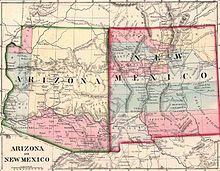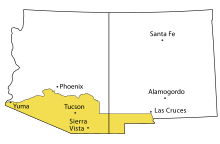| Revision as of 21:24, 3 August 2012 editPhnomPencil (talk | contribs)Autopatrolled, Extended confirmed users, Pending changes reviewers46,201 editsm →Territorial evolution: Fixing links to disambiguation pages -- Nogales using AWB← Previous edit | Revision as of 03:18, 3 September 2012 edit undoQworty (talk | contribs)13,129 editsm →Compromise of 1850 and disputes over slavery: fixing dangling modifierNext edit → | ||
| Line 65: | Line 65: | ||
| As one of the final attempts at compromise to avoid the Civil War, House ]s offered to admit New Mexico as a slave state immediately. | As one of the final attempts at compromise to avoid the Civil War, House ]s offered to admit New Mexico as a slave state immediately. | ||
| Although approved by committee on December 29, 1860, the South did not take up this offer.{{clarify|date=March 2011|reason="the South" had mostly abandoned Congress by then, those left had little power}} | Although the measure was approved by committee on December 29, 1860, the South did not take up this offer.{{clarify|date=March 2011|reason="the South" had mostly abandoned Congress by then, those left had little power}} | ||
| <ref>{{cite book|title=The Impending Crisis|author=David M. Potter|pages=533–534|url=http://books.google.com/books?id=plCTI4F_-HYC | isbn=978-0-06-131929-7 | year=1976 | publisher=Harper & Row}}</ref> | <ref>{{cite book|title=The Impending Crisis|author=David M. Potter|pages=533–534|url=http://books.google.com/books?id=plCTI4F_-HYC | isbn=978-0-06-131929-7 | year=1976 | publisher=Harper & Row}}</ref> | ||
Revision as of 03:18, 3 September 2012
| Territory of New Mexico | |||||||||||||||||||
|---|---|---|---|---|---|---|---|---|---|---|---|---|---|---|---|---|---|---|---|
| Organized incorporated territory of the United States | |||||||||||||||||||
| 1850–1912 | |||||||||||||||||||
 Flag
Flag | |||||||||||||||||||
 A map of the Arizona and New Mexico territories, showing existing counties. | |||||||||||||||||||
| Capital | Santa Fe | ||||||||||||||||||
| Government | |||||||||||||||||||
| • Type | Organized incorporated territory | ||||||||||||||||||
| Governor | |||||||||||||||||||
| • 1851-1852 | James S. Calhoun | ||||||||||||||||||
| • 1910-1912 | William J. Mills | ||||||||||||||||||
| Legislature | New Mexico Territorial Legislature | ||||||||||||||||||
| History | |||||||||||||||||||
| • Treaty of Guadalupe Hidalgo | May 30, 1848 | ||||||||||||||||||
| • Organic Act | 9 September | ||||||||||||||||||
| • Gadsden Purchase | June 24, 1853 | ||||||||||||||||||
| • Colorado Territory established, removing those lands from New Mexico Territory | February 28, 1861 | ||||||||||||||||||
| • Arizona Territory split off | February 24, 1863 | ||||||||||||||||||
| • Statehood | 6 January | ||||||||||||||||||
| |||||||||||||||||||

The Territory of New Mexico was an organized incorporated territory of the United States that existed (with varying boundaries) from September 9, 1850, until January 6, 1912, when the final extent of the territory was admitted to the Union as the State of New Mexico.
Before the Territory was organized
Main article: U.S. provisional government of New MexicoIn 1846, during the Mexican-American War, the U.S. provisional government of New Mexico was established. Territorial boundaries were somewhat ambiguous. After Mexico formally ceded the region to the USA in 1848, this temporary wartime government persisted until September 9, 1850.
Earlier in the year 1850, a bid for New Mexico statehood was underway under a proposed state constitution outlawing slavery. The proposed state boundaries were to extend as far east as the 100th parallel and as far north as the Arkansas River, thus encompassing the present-day Texas and Oklahoma panhandles and parts of present-day Kansas, Colorado, Utah, and Arizona, as well as most of present-day New Mexico. Substantial opposition to this plan came from Texas, which claimed much of the same territory, although not actually controlling those lands.
Compromise of 1850 and disputes over slavery
The Congressional Compromise of 1850, taking effect on September 9th of that year, halted the 1850 bid for New Mexico statehood. At the same time, other provisions of the Compromise of 1850 established the organized New Mexico Territory and the neighboring Utah Territory and firmly established the boundaries of the state of Texas that persist to this day.
The status of slavery during the territorial period provoked considerable debate. The granting of statehood was up to a Congress sharply divided on the slavery issue. Some (including Stephen A. Douglas) maintained that the territory could not restrict slavery, as under the earlier Missouri Compromise, while others (including Abraham Lincoln) insisted that older Mexican legal traditions, which forbade slavery, took precedence. Regardless of its official status, slavery was rare in antebellum New Mexico. Black slaves never numbered more than about a dozen.
As one of the final attempts at compromise to avoid the Civil War, House Republicans offered to admit New Mexico as a slave state immediately. Although the measure was approved by committee on December 29, 1860, the South did not take up this offer.
On February 24, 1863, during the American Civil War, Congress established the new Arizona Territory by splitting off the western portion of the New Mexico Territory -- lands that would ultimately become the state of Arizona and the southernmost part of Nevada. The act of establishment, known as the Arizona Organic Act, abolished slavery in the Arizona Territory.
Territorial evolution


The boundaries of the New Mexico Territory at the time of establishment (September 9, 1850) contained most of present-day New Mexico, more than half of present-day Arizona, and portions of present-day Colorado and southern Nevada. Although this area was smaller than what had been included in the failed statehood proposal of early 1850, the boundary disputes with Texas had been dispelled by the Compromise of 1850.
The Gadsden Purchase was acquired by the USA (from Mexico) in 1853. This added today's southern Arizona and a smaller area in today's southwestern New Mexico to the New Mexico Territory, bringing its land area to the maximum size of its history as an organized territory.
Colorado Territory was established by the Colorado Organic Act on February 28, 1861, with the same boundaries that would ultimately constitute the state of Colorado. This Act removed the Colorado lands from New Mexico Territory.
The creation of Arizona Territory on February 24, 1863 by the Arizona Organic Act removed all the lands west of the 109th meridian from New Mexico Territory, i.e. the entire future state of Arizona plus the land that would eventually become southern Nevada. This Act left New Mexico Territory with boundaries identical to the eventual state of New Mexico.
Civil War
Main article: New Mexico Territory in the American Civil WarAs the route to California, New Mexico Territory was disputed territory during the American Civil War. Settlers in the southern part of the Territory willingly joined the Confederate States of America in 1861 as the Confederate Arizona Territory. This territory consisted of the southern half of New Mexico Territory, in contrast to the Arizona Territory established by the Union in 1863, which was the western half. The Confederate Arizona Territory was the first American political/geographical entity called Arizona.
The Battle of Glorieta Pass placed the area under the control of the Union. However, the government of the Confederate Arizona Territory persisted until the end of the Civil War, in exile in El Paso, Texas.
See also
- Adams-Onís Treaty, 1819
- American Civil War, 1861–1865
- Compromise of 1850
- Gadsden Purchase, 1853
- Governors of the Territory of New Mexico
- History of New Mexico
- Mexican-American War, 1846–1848
- Territorial evolution of the United States
- Territories of Spain that encompassed land that would later become part of the Territory of New Mexico:
- Nueva Vizcaya, 1562–1821
- Santa Fé de Nuevo Méjico, 1598–1821
- Tejas, 1690–1821
- Sonora y Sinaloa, 1732–1821
- Luisiana, 1764–1803
- Territory of France that encompassed land that would later become part of the Territory of New Mexico:
- Louisiane, 1682–1764 and 1803
- States and territory of Mexico that encompassed land that would later become part of the Territory of New Mexico:
- Santa Fé de Nuevo México, 1824–1848
- Coahuila y Tejas, 1824–1836
- Sonora y Sinaloa (Estado de Occidente), 1824–1830
- Sonora, 1830
- Territorial claim of the Republic of Texas, 1836–1845
- U.S. territories that encompassed land that would later become part of the Territory of New Mexico:
- Louisiana Purchase, 1803–1804
- District of Louisiana, 1804–1805
- Territory of Louisiana, 1805–1812
- Territory of Missouri, 1812–1821
- Former territorial claim of the Republic of Texas, 1845–1850
- U.S. military government of New Mexico, 1846
- U.S. provisional government of New Mexico, 1846–1850
- Mexican Cession, 1848
- State of Deseret, 1849-1850 (extralegal)
- U.S. territories that encompassed land that had previously been part of the Territory of New Mexico:
- Territory of Colorado, 1861–1876
- Territory of Arizona, 1863–1912
- U.S. states that encompass land that had once been part of the Territory of New Mexico:
- State of Nevada, 1864
- State of Colorado, 1876
- State of New Mexico, 1912
- State of Arizona, 1912
- Territories of Spain that encompassed land that would later become part of the Territory of New Mexico:
- Treaty of Guadalupe Hidalgo, 1848
References
- http://www.blackpast.org/?q=aaw/new-mexico-territory-slave-code-1859-1867
- David M. Potter (1976). The Impending Crisis. Harper & Row. pp. 533–534. ISBN 978-0-06-131929-7.
- William L. Marcy. "The Avalon Project: Gadsden Purchase Treaty: December 30, 1853". Yale University. Retrieved 2008-10-10. The Purchase treaty defines the new border as "up the middle of that river (the Rio Grande) to the point where the parallel of 31° 47' north latitude crosses the same 31°47′0″N 106°31′41.5″W / 31.78333°N 106.528194°W / 31.78333; -106.528194; thence due west one hundred miles; thence south to the parallel of 31° 20' north latitude; thence along the said parallel of 31° 20' to the 111th meridian of longitude west of Greenwich 31°20′N 111°0′W / 31.333°N 111.000°W / 31.333; -111.000; thence in a straight line to a point on the Colorado River twenty English miles below the junction of the Gila and Colorado rivers; thence up the middle of the said river Colorado until it intersects the present line between the United States and Mexico." The new border included a few miles of the Colorado River at the western end; the remaining land portion consisted of line segments between points, including 32°29′38″N 114°48′47″W / 32.49399°N 114.813043°W / 32.49399; -114.813043 at the Colorado River, west of Nogales at 31°19′56″N 111°04′27″W / 31.33214°N 111.07423°W / 31.33214; -111.07423, near AZ-NM-Mexico tripoint at 31°19′56″N 109°03′02″W / 31.332099°N 109.05047°W / 31.332099; -109.05047, the eastern corners of NM southern bootheel (Hidalgo County) at 31°47′02″N 108°12′31″W / 31.78378°N 108.20854°W / 31.78378; -108.20854, and the west bank of Rio Grande at31°47′02″N 106°31′43″W / 31.78377°N 106.52864°W / 31.78377; -106.52864
- Department of State - Gadsden Purchase
- New York Times - The New Territory of Arizona
- National Park Service - The Battle of Glorieta